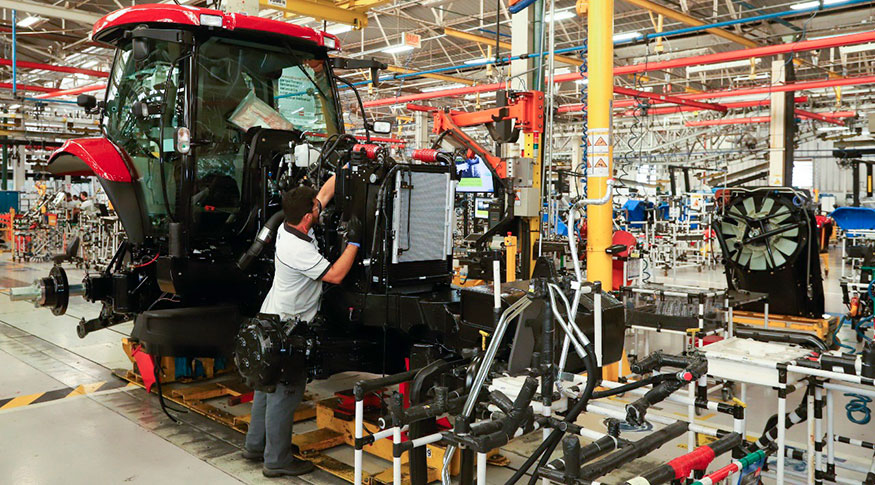National industry
Industrial output changes 0.3% in March, drops in first quarter
May 03, 2022 09h00 AM | Last Updated: May 03, 2022 01h23 PM

After rising 0.7% in the previous month, the industrial output registered a positive change of 0.3% between February and March. Compared with 2021, the sector accumulates a drop of 4.5% in the first quarter of 2022. These data are from the Monthly Survey of Industry (PIM), released today (3) by the IBGE. The cumulative index in the last 12 months hit 1.8%. In March, the industrial production stood 2.1% below the pre-pandemic level, of February 2020.
André Macedo, manager of the survey, explains that the maintenance of the positive behavior in February and March could not offset the loss of 2% recorded in January. In addition, the factors that jeopardize the upturn of industry still remain in place. “Complicating supply issues, which is more global, affected by the foreign market, and in the domestic demand,” exemplifies him.
According to Macedo, the industrial plants still perceive the increase in the production cost and reflect the shortage of some raw materials. “In addition, inflation has been reducing the available income and interests rise and make credit more expensive. Although the labor market shows some improvements, it still shows indexes like a wage bill that does not advance,” reminds Macedo.
The activity that mostly influenced positively in March was that of motor vehicles, trailers and bodies, which rose 6.9%. Working as a thermometer of the overall industry, this sector expanded for the second month, though it does not offset the January´s index.
Other activities that contributed to the positive change in March were: other chemicals (7.8%), beverages (6.4%) and machinery and equipment (4.9%), as well as computer, electronic and optical products (7.9%), leather, traveling goods and footwear (8.9%) and mining and quarrying industries (0.9%).
Among the 12 activities that dropped, the major influence came from food products (-1.7%), which interrupts four consecutive months of rises, when it accumulated an expansion of 14.9%. “Besides starting from a higher index, some specific items, with a more volatile production, like sugar, managed to contribute to the drop in this sector,” states Macedo.
Coke, petroleum products and biofuels (-2.1%) and pharm-chemicals and pharmaceuticals (-8.4%) also exerted significant impact this month. The retreat in the activities of the sectors of fabricated metal products (-3.6%) and electrical machines, appliances and material (-4.9%) should also be considered.
Three out of four major economic categories rose, being capital goods (8%) and durable consumer goods (2.5%) those with the highest positive rates. The sector producing intermediate goods (0.6%) registered a lower growth than that in February (1.8%). Semi and non-durable consumer goods (-3.3%) was the only one with a negative rate, interrupting three consecutive months of advances in the output, a period in which it accumulated a rise of 4.3%.
Production fell 2.1% compared with March 2021
Compared with the same month of the previous year, the industrial sector fell 2.1% in March 2022. The negative results hit three out of four major economic categories, as well as 17 out of 26 sectors, 55 out of 79 groups and 60.1% of the 805 products surveyed. It is worth mentioning that March 2022 had 22 business days, one less than March 2021.
Among the activities, the drops in rubber and plastic products (-14.5%), fabricated metal products (-15.9%) and electrical machines, appliances and material (-20.8%) stood out. In the group of the nine sectors that grew, other chemicals (8.0%) and beverages (12.0%) exerted the major influences.
Among the major economic categories, the segment of durable consumer goods(-12.8%) registered the sharpest drop. Intermediate goods (-2.2%) and semi and non-durable consumer goods (-1.2%) also recorded negative results. Having risen 4.4%, only capital goods grew.
More on the survey
PIM Brazil has been producing short-term indicators since the 1970s regarding the behavior of the real product of the mining and quarrying and manufacturing industries. From May 2014, the release of a new series of monthly industrial production indices began, after a reformulation to: update the sample of activities, products and respondents; prepare a new weighting structure for the indices based on the most recent industrial statistics, in order to harmonize with the needs of the implementation the National Accounts Series - reference 2010; and to adopt the new classification of activities and products used by other industry surveys from 2007 onwards, namely: the National Classification of Economic Activities - CNAE 2.0 and the List of Industrial Products - PRODLIST-Industry.
The survey results can also be consulted in the Sidra database.




















